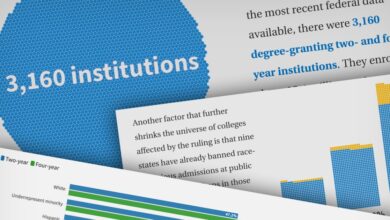White, Wealthy Students Are Overrepresented Among College Transfer Applicants

[ad_1]
A new report from the Common App finds that the college-transfer process, long promoted as a way to help disadvantaged students earn four-year degrees, disproportionately serves students who are already well represented across higher education.
The nonprofit, which allows undergraduate applicants to fill out one application and submit it to multiple institutions, started in 1975 with about 15 members and has since grown to more than 1,000 active members. In 2018–19, it released the Common App for transfer platform to make the often difficult process of transferring between colleges more streamlined and less confusing. In an effort to diversify the overall applicant pool, the Common App provided reduced fees and more targeted outreach to minority-serving institutions, which now make up 133 of its active members.
Our analysis reveals that the majority of applicants on the transfer platform were from traditionally well-served populations.
The hope was that the nonprofit’s efforts would increase the percentage of transfer applicants from underrepresented backgrounds, including first-generation, older, and low-income students. Those changes have made little impact in the representation of students applying to transfer, at least during the four years the Common App has collected such data. “Our analysis reveals that the majority of applicants on the transfer platform were from traditionally well-served populations,” a summary of the report concluded. “These findings are somewhat concerning given that the college-transfer process should reflect educational mobility for all students, especially for historically excluded groups.”
The trends the Common App found are consistent with reports that show minority and underrepresented students transferring at lower rates than their more privileged counterparts, said Trent Kajikawa, senior manager of data operations at the Common App.
“This is just additional evidence that there’s a ton of work in this transfer space when it comes to supporting students,” he said in an interview. Among the steps the nonprofit is taking is making sure that students are aware of transfer-guarantee programs that automatically accept students who meet certain admissions criteria.
The Common App found that over the four years it studied, only a quarter of applicants were from underrepresented minority groups, a third were the first in their families to attend or graduate from college, and just 6 percent were from ZIP codes with a median household income in the bottom quintile. Fifty-five percent of applicants came from ZIP codes in the top quintile.
A report last year from the National Student Clearinghouse Research Center found that transfer rates took a plunge during the Covid-19 pandemic, in part because of declining enrollments at community colleges. Students also encountered more logistical hurdles getting credits transferred and tracking down transcripts. Historically Black colleges and universities were an exception. Their incoming transfer rates increased nearly 8 percent in 2020 after an 11-percent decline the previous academic year.
The colleges receiving the most transfer applications through the Common App, according to the new report, were public flagships and selective universities with large student enrollments. Among the most popular destinations were large private, nonprofit universities that admit fewer than one in four applicants. Colleges that admit at least three out of four applicants accounted for less than 30 percent of applications. The findings provided further evidence of how flagship universities are prospering at a time when public regionals are struggling to fill seats.
While the typical college applicant applies to six colleges, prospective transfers narrowed their pool to two, reflecting “a more focused and deliberate” search, the report said. Most transfer applicants came from community colleges that concentrated more on preparation for four-year degrees than on career and technical programs.
[ad_2]
Source link






